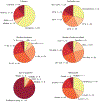The Confidence Database
- PMID: 32015487
- PMCID: PMC7565481
- DOI: 10.1038/s41562-019-0813-1
The Confidence Database
Abstract
Understanding how people rate their confidence is critical for the characterization of a wide range of perceptual, memory, motor and cognitive processes. To enable the continued exploration of these processes, we created a large database of confidence studies spanning a broad set of paradigms, participant populations and fields of study. The data from each study are structured in a common, easy-to-use format that can be easily imported and analysed using multiple software packages. Each dataset is accompanied by an explanation regarding the nature of the collected data. At the time of publication, the Confidence Database (which is available at https://osf.io/s46pr/) contained 145 datasets with data from more than 8,700 participants and almost 4 million trials. The database will remain open for new submissions indefinitely and is expected to continue to grow. Here we show the usefulness of this large collection of datasets in four different analyses that provide precise estimations of several foundational confidence-related effects.
Figures





References
-
- Mamassian P Visual Confidence. Annu. Rev. Vis. Sci 2, annurev-vision-111815–114630 (2016). - PubMed
-
- Peirce CS & Jastrow J On Small Differences in Sensation. Mem. Natl. Acad. Sci 3, 75–83 (1884).
-
- Ratcliff R, Van Zandt T & McKoon G Process dissociation, single-process theories, and recognition memory. J. Exp. Psychol. Gen 124, 352–74 (1995). - PubMed

